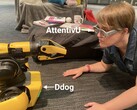MIT Engineers have developed a super tiny battery that could allow us to use cell-sized robots for all sorts of things, like delivering medicine right inside our bodies or sniffing out gas leaks in pipelines.
This new battery is just 0.1 millimeters long and 0.002 millimeters thick—basically the size of a human hair. It grabs oxygen from the air and uses it to oxidize zinc, cranking out a current of up to 1 volt. That’s enough juice to power small circuits, sensors, and little actuators, which is a game changer for making robots work.
The research team, led by Ge Zhang, PhD '22, and grad student Sungyun Yang, published their findings in Science Robotics. They tackled a major hurdle in making tiny robots: how to give them enough power to run on their own without needing to plug into something.
Unlike those "marionette" robots that need a constant light source or a cord to an external power source, this new zinc-air battery lets them move around freely.
The team has already shown that the battery can power different components, like a robotic arm (that’s an actuator), a memristor (which can remember things), and even a clock circuit. Plus, it can run two types of sensors that change their electrical resistance when they detect certain chemicals around them.
One of their goals is to create tiny robots that could be injected into the body to deliver drugs like insulin right where they’re needed. For that, they’re thinking about using materials that are friendly to the body and would break down when the robots are done doing their job.
The MIT crew is also looking to boost the battery’s voltage, which could open up even more possibilities.
This research was supported by several organizations, including the U.S. Army Research Office, the Department of Energy, and the National Science Foundation.
Source(s)
MIT (in English)
















